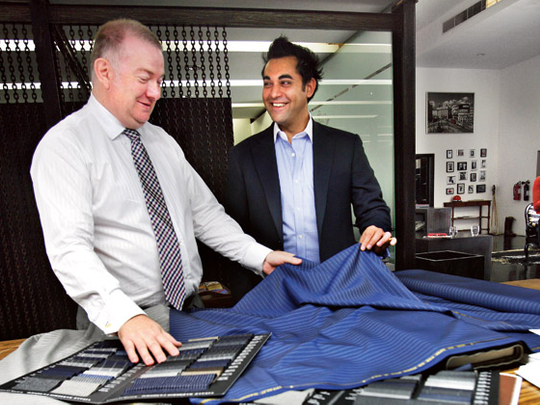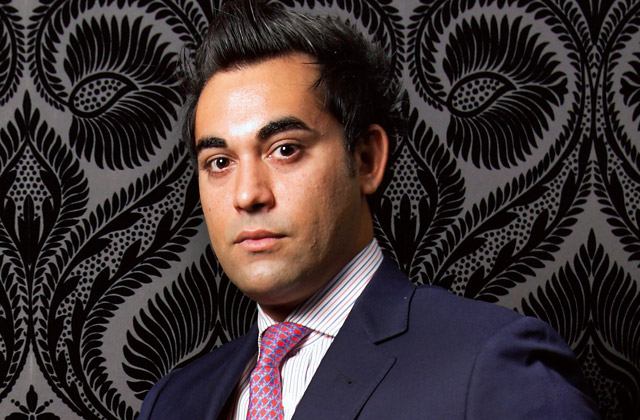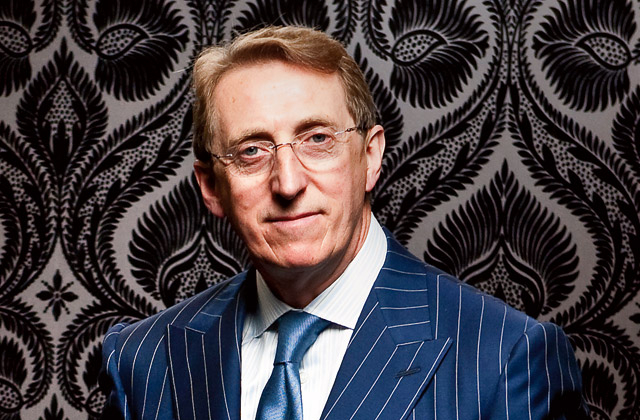
David Matthew Odgiers has just been recruited by one of the big-name German engineering firms. The salary isn't huge, but the deal includes a nice chunk of company stock. He's also been given a signing bonus of Dh50,000.
The catch is that he has to be dressed to the nines while negotiating deals across Europe, West Asia and the Middle East. For a person who - as a developer of a web start-up - is used to khakis and T-shirts matched with his favourite Nikes, it's a big change. An new wardrobe is called for.
This is a case study for master clothier Leonard Logsdail, who at 21 was the youngest man to open shop on London's iconic Savile Row. He would suggest a radical approach to spending that Dh50,000 on the right wardrobe for Odgiers' new role.
Rather than struggling through the hit-or-miss process of going into one shop after another, hoping to find salespeople with expertise and imagination, why not let a talented tailor take on the entire job?
"In the end, it will take less time, that precious commodity you never have enough of," says Zulf Hyatt-Khan, marketing director, Logsdail London, Dubai. "Though the cost may be a little higher, you'll be able to rise above the minor fashion trends that can age a wardrobe before its time. Also, you'll get the right kind of sartorial advice that few retail salespeople are able to give."
After the initial minor inconvenience of fittings and a wait of six to eight weeks, you will be the owner of bespoke clothes that give you major bragging rights.
Suits can cost anything between Dh4,000 to 30,000. "There are fabrics that cost around Dh10,000 a yard, so it depends on the fabric you choose," says Hyatt-Khan. "But we don't tend to focus on the high end of the spectrum. It is for people who can afford it."
Your clothes should look like they belong to you
When I ask Leonard Logsdail why should I buy a bespoke suit at Logsdail, he replies, "Firstly, because you want to!"
He adds, "Also because you have reached a point in your life whereby your pocket book and your social status have given you the desire to look more stylish and elegant, and you want your clothes to look like they belong to you. You have come to the conclusion that having a flashy label in a garment doesn't always give you quality and integrity and [it has] a short-lived life in your wardrobe because the colour or the style is only a five-minute wonder."
Logsdail's Dubai atelier opened two years ago. Does he feel his international clients would be happy to be clothed here? "Yes of course they would," he replies. "I would not have let my name be associated with anything I didn't think could carry on the things I have built up in my career.
"I have known some of the Dubai team a long time and they are as committed as I am to providing the service and advice that I myself do here in New York or wherever I go. The Dubai team really has taken on board my ethos of it all about being a pleasure to buy good clothes. They have a style and humour that is a reflection of what I want to see my name connected with. I get involved with Dubai on a daily basis and oversee all the orders they take there and the garments are made only in workrooms that I myself use. And of course, if a Dubai client wants me to personally measure them I would be delighted to fly over and do that and take their order; it's what we call the ‘Signature Collection'."The Dubai team of Hyatt-Khan and chief clothier Simon Parton displays all the attributes Logsdail demands of it. Parton takes pains to show customers the variety of fabric and styles that would suit a particular customer, while Hyatt-Khan puts them at ease with his banter.
"We have a wide range of different fabrics here, and I try to find out exactly what a customer wants when they come in," says Parton. "Is it for a special occasion, a wedding, or is it just a work or business suit he's looking for? All this matters because it's pointless for me to show him all the fabrics we have. It has to be appropriate."
The first thing Parton does is get to know his customer. "This is a very personalised business anyway, you have to know what your customers like, and what they don't," says Parton. "For instance, this new fabric I've got from Dormeuil… I will call up some of my customers who I know will be interested in getting a suit in that material."
Selecting the right fabric is an art in itself. "There are some customers who come here, they just love clothes, they just enjoy the idea of something special. One gentleman we have is based in Singapore and he is a Dormeuil freak. He actually comes in with certain cloth numbers and insists on them."
Cloth is graded according to fineness of the yarns used, and the higher the thread count the finer and softer the fabric feels.
"In this part of the world I think people tend to be from two extremes; they wear a suit because they have to for work or they wear it because they enjoy it," says Parton. "There are not many in-between here. In places like London people wear a suit because they feel they have to. But here it's a purchase they make because they enjoy it. Tailors in London have a very stuffy reputation and customers sometimes feel intimidated by them. We aim to please. We advise our clients of course, but if they insist on a particular thing we make it for them despite our misgivings.
"Once Leonard was asked what if a customer asked him to make a pink suit. He replied, ‘I'd probably tell him he's extremely stupid, but at the end of the day I'll make it for him'. It's my job to tell him he'll look stupid, but in the end it's his decision."
It's important to be a good listener
Logsdail sets the record straight. "I cater for anyone who wants to buy into my way of making a suit. It's my job to advise my clients on what I think will look good on them in terms of fabric, texture, colour, and of course style. So if we get along with each other it becomes a collaboration. They have their ideas and I have mine and somewhere in there we can make them look elegant and stylish.
"It works in almost all cases. Tailors and clients have to have an understanding of each other and they both have to be very good listeners."
Do master clothiers keep up with fashion trends, or do they dictate fashions? "Yes, of course I keep an eye on fashion trends," says Logsdail. "Some excite me in some ways, others merely amuse me. But the old saying that, ‘Fashions fade but style is eternal' still holds very true in my book. I create fashion every day - it's just to a larger or lesser degree depending on my clients' needs. Style in a gentleman will always looks fashionable. And in many ways it's my job to change styles without anybody noticing."
Logsdail is also a designer for stars such as Robert De Niro, Denzel Washington and Russell Crowe, and he has designed costumes for Hollywood hits. How does designing for movie stars differ from his day job? "It doesn't really - after all, you are just catering for their needs like any other client," says Logsdail.
"Movies do of course look back - or forward - in terms of when the films are set, so when I worked on American Gangster for example, I had to research, or in my case remember, the styles and fabrics of the Sixties and Seventies to make sure that quite flamboyant look in many cases was portrayed by the clothes I made for Denzel Washington. I do enjoy working on films - it's demanding but enjoyable. One never knows what the director or the wardrobe designer will come up with next, but that makes it exciting. The difficulty comes not from what they need, but when they need it. Time frames in the film world tend to be immediate so we often burn the midnight oil."
Logsdail doesn't find it taxing designing for films. "I do enjoy the personal contact with the actors and directors because as with any client you need to know them to make clothes for them. The likes of Hugh Jackman and Robert De Niro are very differing characters so you have to get to know them in person. There have also been some wonderful moments too, as when I was working on The Good Shepherd with Mr De Niro, who also directed the film as well. He asked me to appear in the film, as a tailor no less. A truly wonderful experience!"
So what next? "Who knows? I am getting older and I'd like to think wiser, but I also have no desire to rule the world," says Logsdail. "I don't want to see my name on a dog's coat as has happened with other ‘designers' but I also don't knock them.
"With the team in Dubai building a good business we may look at new opportunities in other cities or countries, but it would have to be in keeping with what we have built together so far."
The classic suit
"The classic suit has to be one that looks great on the individual," says Leonard Logsdail. "One that is an expression of their personality in some ways, but one that makes them look great but also feel great. For me, almost every gentleman looks his best in a dark navy suit. It's slimming, it's stylish; the colour looks expensive and as a garment it is the most versatile. It looks sharp when worn formally with a necktie, but equally is not out of place when worn with an open-neck shirt."
Logsdail London, Warehouse 17 b, St 6, Al Quoz 3, behind Times Square. Tel: 04 323 3148. info@logsdaillondon.com
By the way …
"I do feel despite London's tradition for tailoring in Savile Row in particular, New York has some of the best tailors in the world," says Leonard Logsdail. "Possibly because it has over the years been a magnet for immigrant workers from all over the world, but also because I think the clients in New York seem to be much more knowledgeable about clothes than Londoners. They are genuinely interested in fabrics and styles and many have a firm view on what they are looking for. The British guys tend to want you to make a suggestion on fabric and style - whereas the New Yorker in the main knows what he wants when he knocks on my door. I am happy working either way."















